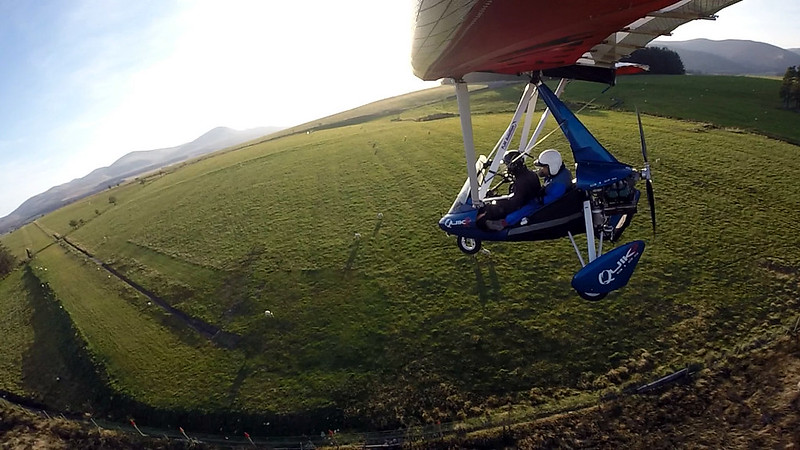BMAA Strip Skills Flight Diploma
Introduction
Enhance Your Knowledge
Improve Your Skills
Gain an Official Diploma
Bag a Couple of New Strips

Course Overview
This post-licence course is designed to make you a safer pilot by reviewing knowledge and improving the flying skills required for landing at more demanding strips, such as private and farm strips. This BMAA Course is designed to develop and reinforce the knowledge and skills required by pilots to tackle these strips safely and with confidence.
The course is designed and approved by the BMAA and can be used as a credit towards the BMAA Wings Scheme. The BMAA notes on the Course can be found on their website here.
(We are a Flexwing-only school at East Fortune and are therefore sorry that we cannot offer this course on fixed wing microlights.)
The course is split into two elements:
- A "Knowledge" element which aims to expand and reinforce the knowledge required to operate from small or challenging airstrips in a variety of conditions. This will take the format of a "Ground School" session and will be a combination of theoretical revision, and in some areas where relevant, a more detailed investigation into the theory involved, to aid the candidate's understanding ahead of putting it into practice.
- A "Skills" (Flight Instruction) element to put the knowledge into practice and also introducing some unfamiliar landing sites.
Knowledge Syllabus
- Review of CAA Safety Sense Leaflets.
- Performance calculations.
- Awareness of hazards.
- Importance of an accurate approach.
- Importance of decision to go-around.
- Review of short/soft field landing techniques.
- Review of crosswind take-off and landing techniques.
- Estimating crosswind/aircraft limits.
- Understanding your own limits / planning an alternate.
Skills Syllabus
- Glide approach.
- Powered approach. Accurate speed control.
- Short field take-off and landing techniques.
- Soft field take-off and landing techniques.
- Crosswind take-off and landing techniques.
- Turbulent/strong wind techniques.
- Planning for and actions following engine failure.
- Go-around procedure. Importance of decision to go-around.
Course Format
Knowledge
This will take the form of a "Ground School" classroom lecture (approximately two hours) with interaction strongly encouraged. It will be delivered in the briefing room at East Fortune - or elsewhere to be mutually agreed. The intention would be to hold this outside normal "training hours", ie. during the evening or perhaps during inclement weather. Attendance at this session is a prerequisite to the Skills element of the course.
Skills
These sessions will take the format of a standard EOSM lesson. In other words, two hours with the instructor to include one hour of logged flying. There will be a briefing to discuss the tasks to be performed, weather, PPR etc, as well as laying out runway markers as required. It can be carried out in your own or the instructor's aircraft. The majority of the flying tasks will be carried out at East Fortune but as part of this course, we're delighted to be able include out landings at two local grass strips not normally available to club pilots (subject to PPR on the day). These two strips are both very close to East Fortune which means valuable learning time won't be used up on standard cross country flying.
Prices and Course Duration
| Knowledge | Classroom lecture (approximately two hours). Could be shared by two candidates together. | £80 |
| Skills (Own aircraft) | Per two hour lesson with the instructor including one hour logged flying time in the candidates's own aircraft. | £110 |
| Skills (Instructor's aircraft) | Per two hour lesson with the instructor including one hour logged flying time in the instructor's aircraft. | £135 |
It is difficult to predict how many flying sessions will be required to complete the course. Some guidance from the BMAA states:
- "There is no minimum or maximum time requirement to complete the course. Practice should continue until the pilot demonstrates an acceptable level of skill."
- "The knowledge and skills required are no different to those taught during primary training for the NPPL(M). The difference is that the Strip Skills course is a dedicated course and will necessarily require far more time to be spent on these specific skills than in primary training."
We believe the course needs a minimum of two flying sessions and candidates should enroll with this expectation. As one example of the standard to be achieved, by the completion of the training, candidates should know how to compute the minimum landing distance from a height of 50' for their aircraft, adjusted for the conditions, and be able safely demonstrate consistent landings to a stop within this distance, on the runway centreline.
Course Instructor
The course will be conducted by Graeme Ritchie (FI). Graeme has been flying Flexwings for over twenty years, instructing full time at East Fortune for seven years and has logged more than 4,000 flying hours. He has extensive Flexwing touring knowledge taking in a very wide range of landing strips over the years.
If you require any further information or to make an arrangement to participate, please contact Graeme on 07887 553816.